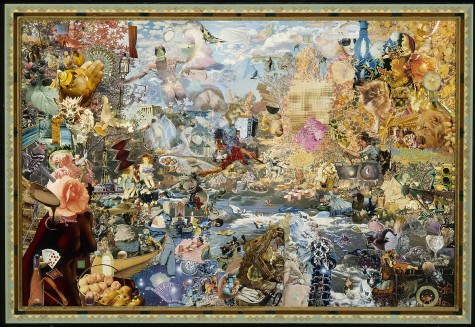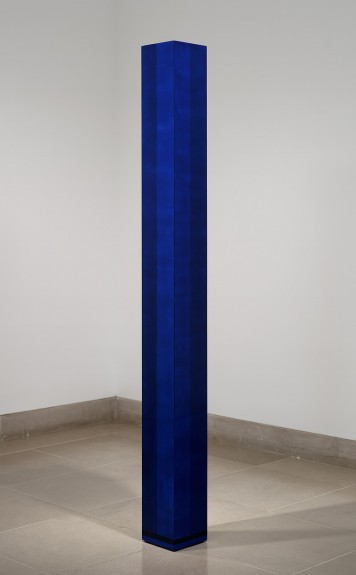May your cups runneth over with joy and cheer in 2011! The DMA Teaching Programs staff wishes you all the best for a happy new year.
[slideshow]
Nicole Stutzman
Director of Teaching Programs and Partnerships
Official behind-the-scenes blog of the Dallas Museum of Art
May your cups runneth over with joy and cheer in 2011! The DMA Teaching Programs staff wishes you all the best for a happy new year.
[slideshow]
Nicole Stutzman
Director of Teaching Programs and Partnerships
The DMA and Radio Disney are teaming up again this year for Noon Year’s Eve on December 31, the perfect way to ring in the New Year if your bedtime is a bit before midnight. The Museum will open at 10:00 am to kick off the three hours of celebration. There will be music and games led by Radio Disney DJ Tera Beal and prizes aimed at visitors ages 6 and under. Everyone is invited to join in on the countdown for when the clock strikes noon. The DMA is also offering a prize for parents and other grown-ups who come, $5 admission and $5 parking in the DMA garage from 10:00 am – 2:00 pm (visitors ages 12 and under are always free at the DMA).
[slideshow]
Inspired by the New Year’s countdown — and the impressive Times Square crystal ball — we created a top ten countdown (without any scientific data or specific parameters) of the past year at the DMA.
10. Turning 107 in January and kicking off a year of great Late Nights at the Museum.
9. The month long celebration of the Arts District, Art in October, with two free admission days to the Nasher Sculpture Center, The Crow Collection of Asian Art, and the Dallas Museum of Art with multiple family programs.
8. Welcoming the DMA-organized exhibition The Mourners from our sister city of Dijon, France in October with an opening weekend featuring a Mourner on stilts and five French chefs.
7. The summer gave us two months of the inspiring and cozy The Living Room installation made of recycled cardboard by artist Jill Foley.
6. Celebrating the bicentennial of Mexico’s independence with nine months of events and two exhibitions featuring Mexican art.
5. September brought the opening of the new C3 exhibition Encountering Space with new works of arts from the DMA collection, a space bar, and a new Arturo’s Nest.
4. Inviting a special guest, The Grinch, to close out a great year of exciting First Tuesdays.
3. Jeff Kinney, author of the popular Diary of a Wimpy Kid, made an appearance as part of the BooksmART series of Arts & Letters Live in April.
2. Launching our quarterly Autism Awareness Family Celebrations in April inviting children with autism and their families to explore C3 and participate in activities an hour before the Museum opened.
1. Our amazing visitors! More than 500,000 of you visited our many exhibitions and programs throughout 2010, we can’t wait to get started on 2011.
2010 also brought the launch of Uncrated. Thank you dear readers and Happy New Year.
Recently, the European galleries on the second floor were reinstalled to present anew some of the greatest works in the Museum’s collection. A cluster of beautiful sculptures commands a corner in the midst of the modern area. Works by Constantin Brancusi, Barbara Hepworth, and Emile-Antoine Bourdelle appear in the foreground, while works by Auguste Rodin and Aristide Maillol can be seen just beyond the window.
Nicole Stutzman
Director of Teaching Programs and Partnerships
Our new installation Re-Seeing the Contemporary displays more than fifty works of the art from the DMA’s captivating contemporary collection. Some of the artists on view range from familiar abstract expressionists to lesser known artists at work today. As 2010 comes to a close, we thought it might be fun to take another look at the exhibition, re-seeing the exhibition into our own top ten list of interesting categories.
1. Paintings: 29
The majority of artworks in the exhibition are paintings.
Pollock changed the definition of painting—instead of painting on the wall or an easel, he laid the canvas on the floor and applied paint to it from above through pouring and dripping.
2. Sculptures off the wall: 9

Larry Bell, The Cube of the Iceberg II, 1975 Dallas Museum of Art, anonymous gift in memory of J. O. Lambert, Jr.
Although not your typical figurative sculpture, this work has a reflective quality that involves the viewer.
3. Sculptures on the wall: 5
Though sculptures are typically displayed using a base or plinth, this work also fits the category because of its three-dimensionality. Since the piece is made out of wire and hangs off of one nail, it must be reshaped with each installation, almost becoming a living thing like the plants or moss it resembles.
4. Collages: 3

Jess, Arkadia's Last Resort; or, Fete Champetre Up Mnemosyne Creek, 1976 Dallas Museum of Art, General Acquisitions Fund
Jess took images from various sources such as jigsaw puzzles, art books, advertisements, and store catalogues and combined them to create a collage in the shape of a landscape.
5. Works never shown before: 6

Jack Whitten, Slip Zone, 1971 The Rachofsky Collection and the Dallas Museum of Art through the DMA/amfAR Benefit Auction Fund
A new acquisition that has not yet been on view, Slip Zone adds to the DMA’s collection of postwar abstract art. Whitten created the unique design by pulling various objects across the wet painted surface.
6. Works by women artists: 5
A few of the female artists are represented in the exhibition:

Susie Rosmarin, Gingham, 1998 Dallas Museum of art, gift of Mr. and Mrs. Bryant M. Hanley, Jr., in honor of Charles Wylie, The Lupe Murchison Curator of Contemporary Art

Anne Truitt, Come Unto These Yellow Sands II, 1979 Dallas Museum of Art, gift of Shonny and Hal Joseph (St. Louis, Missouri) in honor of Cindy and Armond Schwartz
7. Works by Texas artists: 2
Christian Schumann graduated from Booker T. Washington High School for the Performing and Visual Arts, located just blocks away from the DMA.
8. Works with people: 11
At first glance, this collage may appear to be a repetition of the same picture. Upon further inspection, though, you can see that each hand holds a transistor radio, which in turn frames images of people, animals, and objects.
9. Works with text: 14
Inclusion of text is a modern development which Ligon often uses in his art. As the text progresses, it becomes more and more unclear.
10. Works with hot pink: 3
Pink is the color of happiness and works including hot pink just make us smile.

Charline von Heyl, Untitled (3/00), III, 2000 Dallas Museum of Art, gift of Kathleen and Roland Augustine in honor of Robert Hoffman
This painting, a recent museum acquisition, recalls a tropical rainforest inhabited by abstracted animal-like forms. The shocking combination of colors—yellow, green, turquoise, and hot pink—draw your attention to the composition.
Over the holidays we hope you will visit the DMA to discover the countless connections you can make with Re-Seeing the Contemporary and with the larger DMA collection.
Haley Berkman is the McDermott Curatorial Intern for Contemporary Art and Sarah Vitek is the McDermott Education Intern for Adult Programming at the Dallas Museum of Art.
Marilyn Hailey has been a member of the Dallas Museum of Art and a Museum Store volunteer for more than twenty years. Last week, she stopped in to purchase a gift membership as a Christmas gift for a friend. I had the opportunity to sit down and ask her a few questions about why she loves the Museum.
Do you remember why you joined?
MH: A friend had a volunteer position with the Museum Store and was moving. She asked me to take over for her and I did.
If you could have one work of art from the Museum’s collections in your home, what would it be?
MH: Vase of White Lilacs and Roses by Édouard Manet.
What is your favorite activity at the DMA?
MH: I enjoy coming to the exhibition previews on the member days. I love the jazz on Thursday nights as well. I sometimes tell Wendell [Sneed, Jazz in the Atrium Program Coordinator] who to bring back.
What has been your favorite special exhibition?
MH: Splendors of China’s Forbidden City: The Glorious Reign of Emperor Qianlong. That Christmas, every gift I bought was from the Splendors of China’s Forbidden City gift shop. I love oriental art. My husband, HM, and I lived in Japan for a while when he was in the Air Force.
What is a typical day like for you?
MH: I get the newspaper and read the funnies, and then work on the computer crosswords. I spend too much time doing that. I’m in a lot of leagues in the city.
[slideshow]
I recently asked colleagues which artwork from the DMA they would most like to take home and why they like it so much. Below are their responses.
Melissa Nelson:
If I could take home any work of art from the Museum, I would choose Phil Collins’ the world won’t listen. This is a three-part video installation showing ordinary people from Colombia, Indonesia, and Turkey singing their favorite songs from The Smiths’ album of the same title. As an art-lover, it’s amazing to see the global devotion to a British band that spans three non-English speaking countries, expressed through genuinely heartfelt and uninhibited singing and dancing, shown simultaneously on large screens in a pitch-black room. As an avid Smiths fan, it’s impossible for me to view this work of art without wanting to perform the songs myself.
Amy Wolf:
I would like to take home Aria After the Ballet, by Edgar Degas. I wrote about Degas monotypes in my graduate studies, so having this in the collection is wonderful! I like the cool build-up of pastel colors on the figures contrasting against the flat stage backdrop.
Ashley Bruckbauer:
Farm Near Duivendrecht, in the Evening, Piet Mondrian, c. 1916 (Reprise of a compositional Series from 1905-1908). I absolutely love the juxtaposition of positive and negative space in this work and the overall painterly style. It appears at once realistic and abstract, with blocks of warm oranges sharply contrasted by neighboring blocks of cool blues and purples. Also, I love seeing this example of Mondrian, which is so different from the body of work for which he is most famous. I wouldn’t mind if it appeared in my Christmas stocking this year!
Shannon Karol:
I have had such a hard time deciding which artwork I want to take home with me! As of right now, my choice is Carousel Club by Wayne Gonzales (currently in Big New Field). I love the ruby red background and the Kennedy connection. Plus it will fit in my apartment much easier than Robert Rauschenberg’s Skyway (my 2nd choice).
Karen Colbert:
That Gentleman, Andrew Wyeth, 1960; I love this artwork because it exudes serenity. I am always wanting to get a glimpse of the man’s face in the artwork, and although it’s not seen by the viewer, I think the colors, the composition, and subject matter give you snapshot of the type of gentleman he was.
Nicole Stutzman:
Choosing just one work of art is so HARD! But, I would love to share one of my favorite works from Indonesia.
Wall panel with figure of a slain shaman, Indonesia, Taileleu Village, c. 1900. Wood, paint, shell inlay, and cloth.
Why is it one of my favorites?
1) I love the way the maker emphasized the hands of the carved figure. They seem a little too large and slightly out of proportion, and the texture of the hands seems really rough. You can see gouging marks around the fingers from the tools used by the maker to create such a deep relief. I love the physical qualities of the size and texture of the figure’s hands.
2) I also love the stories behind this object. The panel was carved following a headhunting ritual, which was part of festivities surrounding the creation of a new clan house, or uma. It served as a memorial to the headhunting victim and was placed in the front room of the uma. Seen by visitors who entered the house, the panel proved the courage and abilities of the house’s owners. The culture that created this lived on the Mentawai Islands, and they believed that everything around them had a soul – the people, the trees, the houses they inhabited, and more. I think this is a wonderfully powerful perspective to have about the world around you. Part of the beliefs surrounding the creation of the panel focus on the Mentawaian people’s efforts to maintain harmony between all of the spirits and souls in the world. Through this panel they honored the spirit of the slain victim and the materials used to make the panel, as well as the new house and its soul.
Jenny Marvel:
The “Dimension” tea and coffee set; I would love to have this coffee and tea service to have as a conversation piece while entertaining guests during the holidays!
Amy Copeland:
My answer to this question changes all the time, but right now I would most like to take home one of the sketchbooks we have from artist Otis Dozier. Drawings are my favorite media, and I love the bright colors, pale washes, and gestural lines Dozier uses to capture the places he traveled. I’ve seen single pages of his sketchbooks on view before, but they’ve been enclosed in vitrines, so I would welcome the opportunity to turn the pages!
I hope the next time you visit the DMA, you’ll find a favorite artwork.
From all of us here at the DMA, warm wishes for a merry and bright holiday.
Amy Copeland
Coordinator of Go van Gogh Outreach
As the curator of decorative arts and design for the DMA, I oversee a collection of nearly 8,000 works of American and European art. From 17th-century ceramic vases to 20th-century plastic chairs, these holdings are among the Museum’s most expansive and diverse. One aspect of this collection is a growing number of modern and contemporary international design objects, a selection of which has recently been installed in an exhibition in the Museum’s Tower Gallery, Form/Unformed: Design from 1960 to Present. In this installation, we showcase, for the first time, a perspective upon design of the last fifty years as seen through the lens of the DMA’s collections.
Although the DMA began acquiring modern design of the 20th century nearly two decades ago, it has only been in recent years that opportunities to collect contemporary design have been taken, resulting in a host of new acquisitions, such as a tea service and bench by Pritzker Prize-winning architect Zaha Hadid and a witty assemblage of stuffed animals as a chair by the Brazilian design team of the Campana brothers. Many of the objects reflect a logical continuum with the Museum’s historic decorative arts works–whether by function as seating and tableware, or most plainly as aesthetic creations inspired by the era and cultural milieu in which they were fashioned. Even so, a few works in the exhibition, such as Giovanni Corvaja’s “The Golden Fleece” ring, reveal a new collecting interest within the department, that of jewelry. Just this year, over a dozen exceptional examples entered the collection, with yet more growth anticipated in the coming years. Such decisions to expand collecting areas are not made lightly, as resources must be carefully considered and such “new” areas of interest must be reviewed for their logical connections to the DMA’s other collections (in this instance, ancient Greek and pre-Columbian jewelry).
Our new jewelry collecting efforts have been exciting, and as we continue to add new works in this area (and in other arenas of design), you will see additions to this exhibition and the Museum’s galleries–so keep a watchful eye!
Kevin W. Tucker is the The Margot B. Perot Curator of Decorative Arts and Design at the Dallas Museum of Art.
That Gentleman is one of my favorite artworks at the Dallas Museum of Art. This painting, which is located on the 4th floor in the American galleries, was painted by Andrew Wyeth in 1960.
That Gentlemen portrays an elderly African-American man named Tom Clark, who was the neighbor of Mr. Wyeth. Although his face is hidden from the viewer, I’m compelled to further explore this composition with fresh eyes, looking for clues that express his personality. Mr. Wyeth wrote about Mr. Clark, stating: “His voice is gentle, his wit is keen, and his wisdom enormous.” This portrait is a constant reminder of how we should sometimes stop and take notice of the quiet, unsung heroes in our life.
Karen A. Colbert
Teaching Programs Intern
On the first Tuesday of every month, admission to the DMA is free, and we have special activities for our youngest visitors until 3:00 p.m. On December 7, we had a special guest in C3, the Grinch (before his heart grew three sizes in one day). He stopped by from the AT&T Performing Arts Center, where Dr. Seuss’ How the Grinch Stole Christmas! The Musical was opening later that night. DMA staff members could not pass up this photo opportunity.
For this week’s Friday Photo Post, I focused on works of art in the collection made of silver and gold. I decided to do this after singing Silver and Gold from Rudolph the Red-Nosed Reindeer on the way to work. All objects can be found on the third floor of the Museum.
Amy Wolf
Coordinator of Gallery Teaching
[slideshow]